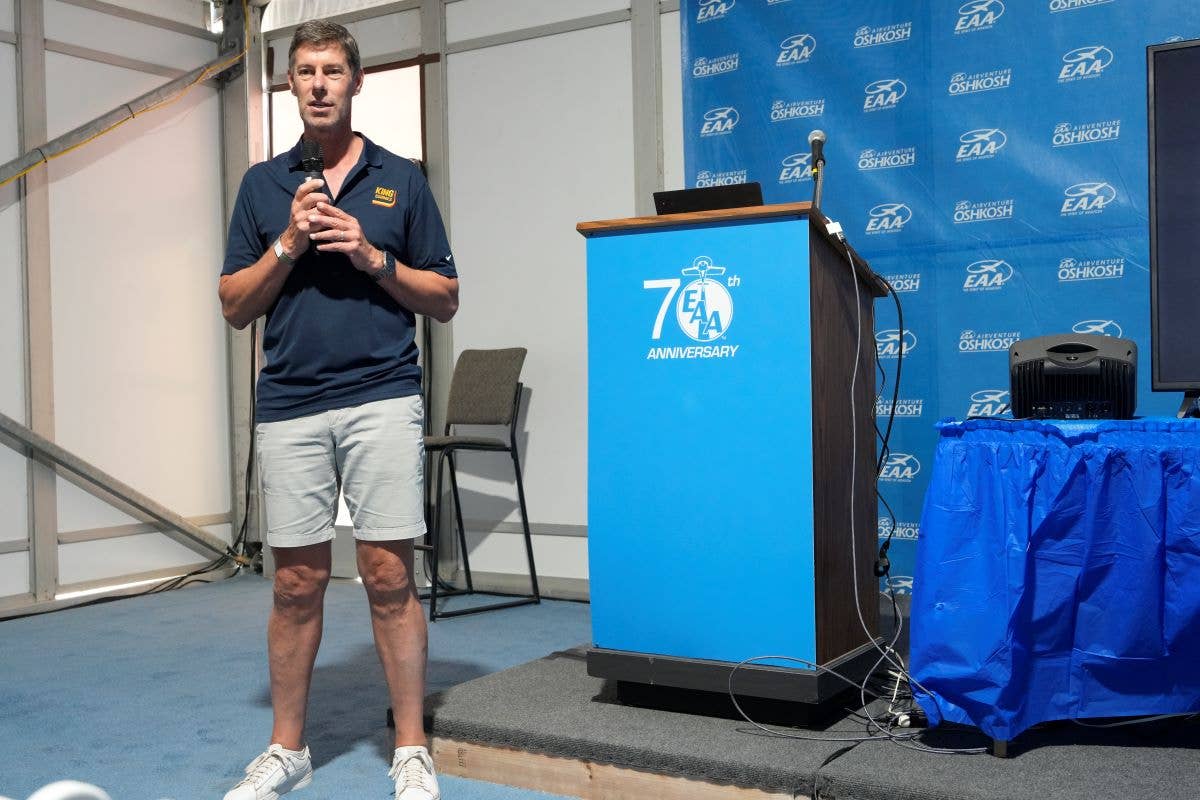King Schools Launches New Curriculum to Address Aviation Mechanic Shortage
The demand for aviation mechanics is surpassing the well-documented pilot shortage, with an expected projected need of roughly 690,000 jobs in the next two decades, according to a study by…

Barry Knuttila, CEO of King Schools, announced the launch of the new Cleared for Aviation Maintenance program at EAA AirVenture. [Credit: Amy Wilder]
The demand for aviation mechanics is surpassing the well-documented pilot shortage, with an expected projected need of roughly 690,000 jobs in the next two decades, according to a study by Boeing. To address this critical issue, King Schools, a renowned provider of aviation training, has introduced a new Cleared for Aviation Maintenance program.
“We’ve been growing a lot over the last five to 10 years…and it’s been wonderful to do that, but we’ve been within this domain of pilots for a long time,” said CEO Barry Knuttila at a press conference at EAA AirVenture in Oshkosh, Wisconsin, on Thursday. “We had mechanics test prep for the general airframe and powerplant for many years. So we had our toe in the mechanics world.”
“Now, we’ve jumped into the water, gone underwater, and come back up,” he continued. “And we’ve come back up with a curriculum that allows…a school to start up a brand new mechanic school and take mechanics…from zero to turning wrenches with a certificate.”
The Cleared for Aviation Maintenance product is designed for flight schools, colleges, and universities to integrate into their existing A&P programs or establish new ones. With a focus on the new Part 147 requirements and a user-friendly syllabus, the product seamlessly integrates into existing instructional programs. King Schools offers a free concierge service to guide schools and businesses through the setup process.
“We saw a demand that’s there,” Brian Hough, senior vice president of sales and business development, who was instrumental in the development of this program, said at the briefing. “There’s more mechanics needed than there are pilots. If we look at that trajectory, what’s that going to do to us? We’re going to come to a grinding halt because we are falling short of that.”
“There’re maintenance schools that are out there,” he continued, “but they’re just not able to produce [a solution to] the overwhelming demand.”
So he took that idea to the drawing board, asking how we could change that dynamic. “I couldn’t find a commercially-produced syllabus, short of…test prep, which we already had, that would work for multiple entities,” Hough said.
Aviation maintenance schools are relatively sparse, but Hough and the King Schools team identified a solution in the exploding flight school business nationwide. There are aviation education programs established and growing across the U.S., and those schools have fleets of aircraft. Fertile ground for educating and training new A&Ps: but how could the dots be connected? Enter Cleared for Aviation Maintenance, which allows learners to complete their course of training at existing schools.
“This year, if you don’t know, the FAA is putting out grants up to $500,000—you have to apply by August 15,” Hough said. “So make sure you do. If anybody has a particular program, this is a huge advantage for you to teach mechanics.”
The curriculum encompasses a fully integrated home-study course, written exam test prep, and a complete syllabus in compliance with the new FAA FAR Part 147 requirements for aviation maintenance technician schools. The program seamlessly aligns with aviation maintenance programs offered by high schools, colleges, and universities, maintenance schools, and flight schools with aircraft maintenance facilities.
There is also a fast-track option for experienced military crew chiefs without A&P certification. These individuals can now benefit from the mechanics training and, in turn, assist the shop while obtaining an FAA certificate more efficiently.
The home-study course is structured into three units: general, airframe, and powerplant. Learners engage with short video sessions, quizzes, flashcards, and practice tests to make the process more enjoyable and improve retention. FAA-style questions ensure students become familiar with the examination format, and interactive tracking helps focus efforts where needed. Additionally, students gain access to the company’s companion and test prep apps, both allowing for offline functionality.

Subscribe to Our Newsletter
Get the latest Plane & Pilot Magazine stories delivered directly to your inbox






